|
|
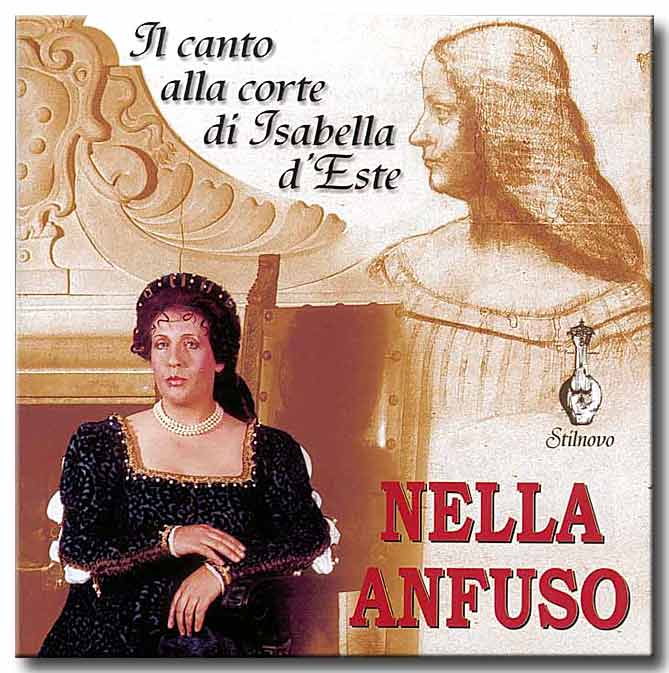 |
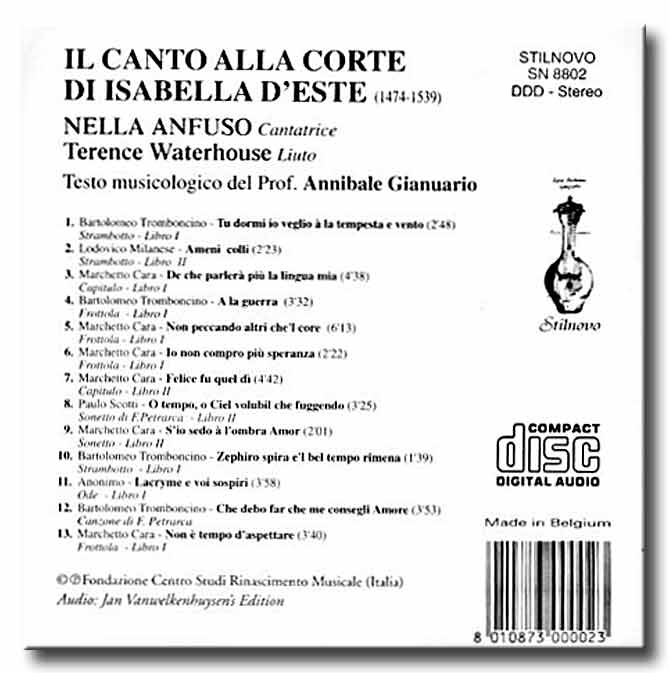 |
|
Nella Anfuso
Cantatrice
Terence Waterhouse
Liuto |
-
Bartolomeo Tromboncino - Tu dormi io veglio a la tempesta e vento
(2'48) Strambotto - Libro I

Exempla - I Pars - download mp3 643 KB |
-
Lodovico Milanese - Ameni colli (2'23) Strambotto - Libro
II
-
Marchetto Cara - De che parlerà più la lingua mia
(4'38) Capitulo
- Libro I
|
-
Bartolomeo Tromboncino - A la guerra
(3'32) Frottola - Libro
I

Exempla - I Pars - download mp3 538 KB |
-
Marchetto Cara - Non peccando altri che'l core
(6'13) Frottola
- Libro I
-
Marchetto Cara - Io non compro più speranza (2'22) Frottola
- Libro I
-
Marchetto Cara - Felice fu quel dì (4'42) Capitulo - Libro
II
-
Paulo Scotti - O tempo, o Ciel volubil che fuggendo
(3'25)
Sonetto di F.Petrarca - Libro II
-
Marchetto Cara - S'io sedo a l'ombra Amor
(2'01 ) Sonetto
- Libro II
|
-
Bartolomeo Tromboncino - Zephiro spira e'l bel tempo rimena
(1'39) Strambotto - Libro I

Exempla - I Pars - download mp3 336 KB |
-
Anonimo - Lacryme e voi sospiri
(3'58) Ode -Libro I
-
Bartolomeo Tromboncino - Che debo far che me consegli Amore
(3'53) Canzone di F. Petrarca
-
Marchetto Cara - Non è tempo d'aspettare
(3'40) Frottola
- Libro I
|
 |

|
|
SINGING
AT THE COURT
OF
ISABELLA
D' ESTE
(1474 - 1539)
 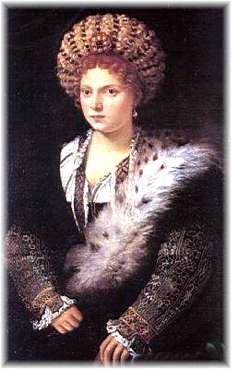
|
|
The return to
Rome in 1377 of the (French) Pope Gregory XI from the See at Avignon, prompted
the transfer of numerous musicians and singers from Northern Europe who,
following the fashion of the day adopted by the Papal Chapel, were eventually to
find employment in the most important choirs in many of the various City States
throughout Italy. Humanist culture at this time was in full bloom in Italy and
all major musicians in the Peninsula became imbued with these Humanist ideals
and acquired clarity of expression and formal elegance in their music. The
irrefutable evidence of this lies in the qualitative difference in the
creations of these composers before and after the influence of Italian
Humanism from which a poetic-musical concept in monodic key developed, which is
in stark contrast to the concept of North European polyphony which is
essentially based on harmonic amalgams and on specific sonorous and rhythmic
researches and fantasias, which are clearly not very expressive.
This Humanist concept continued
throughout the whole of the fifteenth century and its most prestigious centre
was established towards the end of the century at Mantua with Isabella d'Este.
It is a cause of some considerable regret that the majority of the output of
profane music of this period has been destroyed, principally as a result of the
ideological excesses of historical characters such as Savonarola who did not
hesitate for an instant in having works of art and important documents burnt and
destroyed because they considered them to be "pagan" (e.g. the "burning
of the vanities" in Florence in 1496 !).
Reference to the Humanist concept of
this period makes it appropriate to specify a few characteristics of the
principal elements which embody such a concept. It is the period of the
musician-singer "improvisers" (improvvisatori) about whom
considerable evidence still survives. The preferred method of making music at
the time was singing "ad lyram" or "ad citharam"
that is to say, singing to the accompaniment of the viola (o "vihuela")
or of the lute: one only has to recall Lorenzo the Magnificent and his circle of
friends. Lorenzo himself used to sing together with Marsilio Ficino, Domenico
Benivieni, Antonio Naldi and Baccio Ugolini : the latter (a priest and a member
of Lorenzo's Chancellery who towards the end of his life became Bishop of Gaeta)
was considered to be a great expert at singing with the lyra (da braccio)
and in 1480 became the first interpreter of Angelo Poliziano's "Orfeo".
Some of Poliziano's own letters to Lorenzo (dated 5 June 1490) or to Pico della
Mirandola recalling the performance in which he praises Piero dei Medici who "canit
etiam, vel notas musicas vel ad cytharam carmen" (sings moreover, both
polyphonically as well as monodically) still survive. In the early years of the
following century, Paolo Cortese ("De Cardinalatu", 1510) a
Tuscan who had experienced living among the Roman Curia (the most appropriate
circle for drawing together Humanism and polyphony) extolls the praises of
Josquin Despres and cites with varying opinions and judgements other
contemporary maestros of polyphonism and attaches the greatest importance in
musical activity to "canto ad lembum", that is to say singing
with the lute, citing Francesco Petrarca (Petrarch) and Serafino Aquilano as the
two greatest exponents.
|

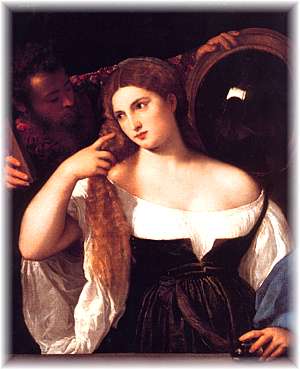 |
|
It
was not merely a question of a simple musical taste but rather of a real aesthetic
concept which was new and the precursor of future developments and it is a poet
who sheds new light on this new concept. Angelo Poliziano in a letter dated Rome
1488 where he found himself on the occasion of Piero dei Medici's marriage to
Alfonsina Orsini, describes the greatly admired singing of the young Fabio:
" He then sang an epic song which he had just composed in praise of our
Piero dei Medici...his voice was almost like the voice of one who was reading
and at the same time was singing yet one could hear both one and the other
voice and distinguish one from the other: at the same time the voice was soft of
the same intonation (as in plain chant) or modulated or changed as the phrase
warranted. At times the voice was varied at others sustained, at times excited
at other times calm, intense, now slowing down and now quick, accelerated ,
always precise, always clear and always pleasant to the ear : and the gestures
were neither understated nor sluggish, but neither affected nor mannered. One
would have thought that an adolescent Roscius was performing on the stage
".
This document anticipates by more
than a century Caccini's "sprezzatura " and the "si
canta senza battuta" (singing against the beat) of the monodic and
polyphonic Monteverdi. Moreover it falls to another poet and man of letters
Vincenzo Calmeta who lived in the fifteenth century till the earliest part of
the sixteenth century (he died in 1508/9) who anticipates Monteverdi's "Seconda
Pratica"; regarding "Qual stile tra' volgari Poeti sia da
imitare" (what style to imitate among Italian vernacular poets) who
affirms that "as for a style of singing they should imitate Cariteo or
Serafino who in our own day have borne the palm in such exercises and they have
endeavoured to accompany their verses and words with plain and fluent music so
that the excellence of their sententious and pithy words can be better and more
clearly understood and appreciated showing the wise judgement that a shrewd
jeweller who has to display a very fine and clear, white, pearl does so not by
wrapping the pearl in a sheet of gold material but rather in a sheet of black
material so that the qualities of the pearl can be shown off to their best
advantage (...) similarly one should consider those who in singing put all their
effort into pronouncing the words well to have the best judgement: when they are
of substance and arrange it so that the music accompanies the words in the
manner that masters are accompanied by their servants so that they can appear to
be even more worthy and honourable so that the emotions and the aphoristic words
should predominate and not be subservient to the music, but rather that the
music should be subordinate to the words and the emotions."
Having lived in such a cultural
climate Isabella d'Este inevitably had to become a prime mover of an art which
complied with the concepts which we have seen so well expressed by the authors
cited above. Her contemporaries did not refrain from extolling her praises in
her role as patron and of artist and with the passing of time she was the
recipient of ever more increasing praise and more through displays of admiration.
Born in Ferrara in 1474 the daughter
of Ercole I d'Este, Isabella moved to Mantua in 1490 on her marriage to
Francesco II. She called to her service several artists including
Lorenzo Costa, Lorenzo Leombruno, Giulio Romano; the sculptor Gian Cristoforo
Romano and for brief periods Leonardo Da Vinci and Raphael. The poets include
Serafino dall'Aquila, Vincenzo Calmeta, Galeotto del Carretto, Pietro Bembo,
Baldassare Castiglione and Lodovico Ariosto. Having received an excellent
musical training, Isabella was an accomplished singer and played the lute, the
cithera, the clavicord and the organ and actively encouraged poetic and musical
activity of the highest quality and of the greatest importance for a period of
almost thirty years. The Lady Marchioness found an already flourishing musical
circle at Mantua: one only has to recall the presence in the small City State of
extemporisers and improvisers such as Zannino dall'Arpa (1458) and Malagise
Fiorentino player of "the cithara and the viol" (1467). But it
is with Francesco Gonzaga in 1484 and with the arrival of Isabella in 1490 that
Italian singers and musicians became systematically employed. In 1511 when
Isabella organised the Chapel Choir she called on no fewer than 12 singers (out
of a total of 17) from Ferrara and appointed Marchetto Cara to the post of
Chapel Master. From this choir which was composed entirely of Italians (with the
exception of a certain Bartolomeo who was Spanish) no fewer than 6 singers later
transferred to the Papal Chapel where Italian singers were being and continued
to be employed.
|

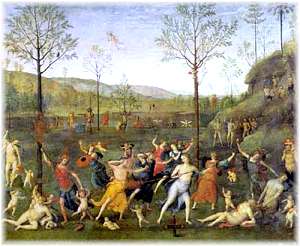 |
|
The musical output at Mantua which
is normally referred to by the metrical and musical terms as "frottolistica
" (songs for four voices) takes its inspiration from the ideals of
expressiveness which are completely unknown to the rest of the contemporary
European scene. At Mantua one sees the flourishing of new metrical forms,
characterised by the expressive immediacy with the "frottola",
the ode (l'ode) the "strambotto" ( a folk-lyric of 6 or
8 lines) the "capitolo " (a poetical composition in terza
rima) the "barzelletta" (a 'light' song) which are joined
to traditional metres like the "sonnet" and the "canzone".
The most important poets of the period include Niccolo da Correggio, Antonio
Tebaldeo, Vincenzo Calmeta, Serafino Aquilano, Panfilo Sasso etc.
The most frequent and recurring
poetic themes include the themes of love: departure, delusion at unrequited
love, declarations of love in a nocturnal settings (serenate) - (serenades)
but also in idyllic and descriptive settings together with invitations in the
manner of Horace to "carpe diem". The present production on
disc offers some of the most important examples (from a paraphrase of the sonnet
"Zefiro torna" (the Zephyr returns) "Zephiro
spira" (Zephyr blows) by Petrarch together with another sonnet "0
del volubil" (Oh inconstant sky) and the Canzone "Che debo
far" (What am I to do ?) also by the great Aretine poet. The musical
score matches fully the character of the expressive immediacy of the poetry.
Even if this was expressed by four separate lines it has a vertical progression
which was performed monodically (in almost all cases) with the "superius"
sung and the other parts played on a musical instrument (usually the lute).
Among the great number of composers
(and singers) of the music- many of them are known to us only by their first
names- the greatest of these are without doubt Marchetto Cara and Bartolomeo
Tromboncino both from the area around Verona. Both were equally and especially
loved and protected by Isabella and they both spent a long period of their lives
at Mantua. Marchetto Cara was probably born in 1465 in the Province of Verona
and died in Mantua (where he moved to in 1494) probably in 1525 or thereabouts.
Bartolomeo Tromboncino was a completely different character and we know that he
was in Mantua in 1495 and that he was especially protected by Isabella on the
occasion of the murder of his wife whom he caught commiting adultery "in
flagrante". In 1513 we find him at Ferrara and later he moved to other
Italian cities, including Florence, and then to Venice where he was to end his
days (a letter written from this city dated 1530 survives).
These are the musicians who were
particularly sought after by poets whether they were major or minor poets, at
the time. Apart from those already cited we should also inevitably recall:
Giorgio Luppatus, Michele Pesenti, Giorgio de la Porta, Antonio Rigum,
Pellegrino Cesena di Verona, Rossino di Mantova, Rossetto da Verona, Nicola
Pifaro, Pietro Aron, Alessandro Demophon, Piero da Lodi, Paolo Scotti, Lodovico
da Milano, Rasmo, Timoteo, Onofrio Padoano, Don Michele Vicentino, Girolamo a
Lauro etc.
|

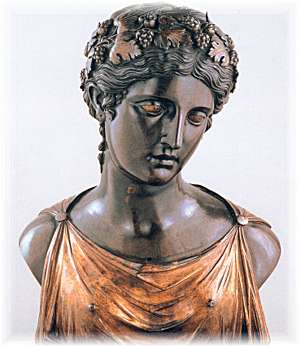 |
|
At the same time that this poetic
and musical flowering was occurring at the Court of Isabella, the birth of music
printing was also taking place thanks to Ottaviano Petrucci di Fossombrone
(1466-1539) who at the end of the fifteenth century obtained a printing
privilege from the Venetian authorities enabling him to print in that city for
20 years. In 1501 he made his printing debut by publishing a collection of music
by musicians and composers north of the Alps (French and Flemish) but the visit
of Marchetto Cara to Venice in 1502 prompted Petrucci to publish a collection of
entirely Italian profane music by the two great composers Cara and Tromboncino
and by Michele Pesenti two years later in 1504. These "Frottole Libro
Primo" form the first of a series of 10 collections which had an
enormous success (the last book of 1514 has been lost but it has been possible
to reconstruct it by means of manuscripts and printed sources from Petrucci's
imitators). Respectively in 1509 and in 1511 he published "Due Libri di
Tenori e contrabassi intabulati col soprano in canto figurato per cantar e sonar
col lauto" ("Two books of music for tenors and contrabassi (double
- bass) intabulated with the soprano in figured music to be sung and played with
the lute") by Franciscus Bossinensis, a musician probably from Bosnia, who
adapted the work of other composers and added his own embellishments and
fantasies. The music on the present disc has been taken from Bossinensis' two
collections.
The practice and performance
corresponded closely to the expressiveness typical of this production at Mantua.
On this subject too the surviving documents are extraordinarily illuminating.
Baldassare Castiglione who knew the Court at Mantua very well, describes for us
in his famous "Cortegiano" ("The Book of the Courtier",
Venice, 1528) the musical performance of two singers at the Court. He praises
Bidon's style of singing "which is so artful, immediate, witty, vehement,
excited and full of such melody that the spirits of those who listen to him are
so moved and become so enflamed and are so suspended that they appear to rise up
to Heaven. Neither is our Marchetto Cara any less able to move us with his
singing but with much tender harmony: who through a placid calm, full of
sweetness, touches the heart and penetrates the soul impressing upon them
sweetly a delightful passion ".
But the most important performer of
this period at Rome, at Mantua at Milan was the poet singer Serafino Ciminelli
known as dall'Aquila orAquilano (1466-1500) who arrived at Mantua in 1494. His
friend Vincenzo Calmeta in his "Vita di Serafino Aquilano"
(Life of Serafino Aquilano) remembers him thus: "He was so passionate in
reciting his poems and was so proficient at accompanying the words to music that
he was able to move the spirit of his listeners be they women, be they learned
or not so learned, he moved them all equally (...) many other musicians and
singers seeing that he had received more fame from reciting rather than from
composing and seeing that his technique and style were very much appreciated by
princes, by the learned and by beautiful women, many of them decided to imitate
him and whilst learning his music, equally had to learn his poems and words:
with the result that within a relatively short period of time his poetry
became very widely spread not only by him but by many other citharists
throughout Italy ".
Another very important document is "The
Apologia of Angelo Colotio on the work of Serafino to the Magnanimous
Piccolomini S. and benefactor" written by one of Serafino's admirers : "They
allow him the possibility of pronouncing the words singly but he endeavoured to
harmonise the words to the lute in order to etch them into the soul of his
listeners in order to arouse them and at other times to calm them just as
Gracchus used his lyre on his Senators ". Even the King of France who
had been afforded the opportunity of listening to him was one of his admirers: "It
is greatly to his credit and to his extreme virtue that a king who is not very
conversant with our customs and our language should derive so much delight and
wonder for the Italian language through his pronunciation ".
The repertoire of "frottole"
became widely spread throughout the whole of Italy and was adopted by male and
female singers alike. Among the female singers apart from Giovanna Moreschi
(Marchetto Cara's wife) and Paola Poccino, active at Isabella's Court, a
manuscript ( Magliabechi manuscript No. VII, 735 at the National Central Library
in Florence, Biblioteca Nazionale Centrale di Firenze) arrived at Isabella's
Court written by Giovanni Mazuoli da Strada (nicknamed Stradino) which transmits
to us the names of "Maria, the woman of Bianchino da Pisa, Masina and
Lionarda the latter the wife of Baccino degli Organi". It almost goes
without saying that the voice "had to he natural" that is to
say, using the whole natural octave either for a male or a female just as it
seems equally obvious that this style of singing did not permit any vocal
flourishes because it was subservient to the word and to the emotion and linked
to the text. Therefore the "falsetto" register was excluded and
the emphasis was more on the full, rich, vibrant voice stetched in expression.
From the technical vocal point of view, the "frottole"
constitute a repertory which can only be truly recreated if its emission is "perfect"
that is to say a realisation of the total fusion or union of registers. It is
therefore the "purity" the "homogeneity'" the "fullness"
and "roundness" the flexibility the "silkiness"
of the voice (its light and shade) which allows the very subtle play of elision "legato"
of the range between "forte" and "piano" of
the "declamation of the text" of all that contributes to the formation
"of the expression in its apparent, very rich, "simplicity".
It is a "transparent" music that is to say, maintained to the
essence of the most pure lyricism and only a vocal technicality of a very high
standard can really do full justice to it.
It
is very fitting to end the introduction to this disc which pays homage to the
Lady who nurtured this typically Italian art with a few lines from a Canzone
dedicated by Trissino to the great Isabella (who also composed "strambotti"
in her own right - one of hers entitled "Arboro son " I am the
arbour - survives) as a singer:
"But when she moves her lips in
song
so much sweetness pours forth from
the Heavens
that the air is gladdened
and the very wind stops intently in
front of such
sweet harmony".
Annibale Gianuario
Musicological text
containing unpublished documents. |
 |
 |
 |

| |



|
